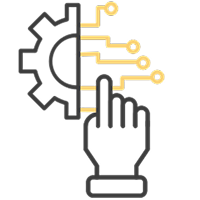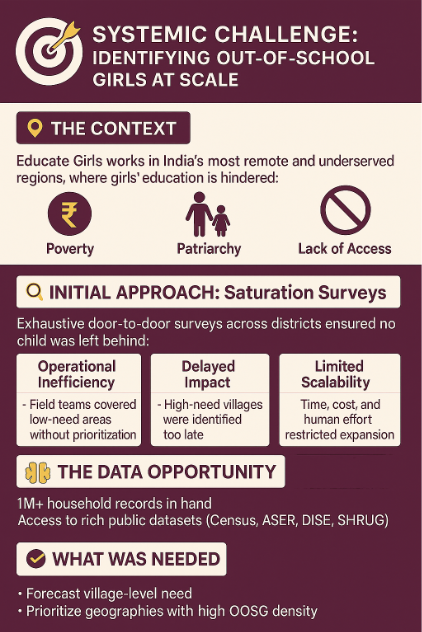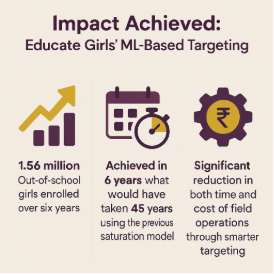Predictive tech to identify and target high-need geographies for out-of-school girl enrolment
Summary
Impact Created
1.56 million
girls enrolled in just 6 years
7x faster
impact compared to the previous model
90%
model accuracy with major cost and time savings
About the organisation
Problem Statement
Educate Girls’ saturation-based model ensured full coverage but, as the program scaled, it struggled with efficiency. Field teams spent equal effort across all areas, leading to delayed impact, strained resources, and limited scalability, highlighting the need for a more targeted, data-driven approach.Solution
Development of a machine learning model that used public and survey data to predict village-level need. This enabled the team to prioritize high-need areas, streamline field operations, and shift from blanket outreach to precision targeting, improving scalability without compromising equity.Key learnings
- Strategic village targeting can exponentially accelerate program reach and cost-efficiency.
- Every model iteration must be grounded in actual field data to ensure reliability.
- Simplifying outputs enabled frontline and expansion teams to use ML insights effectively.
- Using publicly available datasets makes the model portable across states and organizations.
Key Technologies Used
- Python
- Random Forest ML Algorithm
- Census & Public Datasets (DISE, ASER, SECC, SHRUG)
- Custom Dashboards
Quick Facts

Organisation Name
Educate Girls

Organisation Website
Visit Site

Founding Year
2007

Number of Beneficiaries served
1.56 million out-of-school girls enrolled (as of 2023); 18 million+ beneficiaries reached through outreach and engagement

Geography Served
Rajasthan, Madhya Pradesh, Uttar Pradesh

Focus Area
Programmatic Impact and Operational Efficiency

Functions Impacted
Strategic Planning; Expansion Operations; Field Deployment; Monitoring & Evaluation

SDG Addressed
Full Case Study
Challenges
Problem Statement / Challenges Faced
Educate Girls’ saturation-based approach to identifying out-of-school girls ensured full coverage but lacked efficiency and scalability. Field teams spent equal effort in both high- and low-need areas, delaying impact and straining resources.
With a wealth of household and public data available, the challenge was to shift from blanket coverage to data-driven precision targeting without compromising on equity.



Solution
Solution development
Educate Girls partnered with IDinsight to develop a Machine Learning model using the Random Forest algorithm, trained on survey data from 29 districts and enriched with multiple public datasets (Census, DISE, ASER, SECC, SHRUG). The model was designed to:
- Predict village-level concentrations of OOSGs
- Categorize villages into Plans A–D based on need and operational feasibility
- Identify geographic “hotspots” using clustering
- Prioritize interventions using a ranked list of high-need areas
The shift from Strategy 1.0 (saturation) to Strategy 2.0 (data-driven targeting) marked a fundamental evolution in how Educate Girls approached its mission of turning large datasets into actionable, predictive insights.
Solution Roll-Out Approach
Educate Girls approached the implementation of its machine learning solution with a clear focus on precision, usability, and scalability. Recognizing the complexity of deploying advanced analytics in rural contexts, the organization adopted a phased strategy that blended cutting-edge technology with field-based validation. At every stage, stakeholder feedback, user testing, and real-world learning shaped the platform’s evolution ensuring the model not only predicted need but was actionable on the ground.
Initial model development using historical household data and public datasets, tested against known field results.
Model iterations and validations with live field data to refine accuracy. Prediction accuracy reached 90% over three testing cycles.
Operational integration with strategic planning. Expansion teams used ranked village lists to deploy interventions.
Model outputs were simplified for non-technical staff and feedback loops were institutionalized. The model was retrained periodically as new data became available.
The transition was supported by a strong emphasis on user interpretation, ensuring that teams could trust and act on ML insights without needing deep technical knowledge.
Outcomes & Impact
Impact
Educate Girls’ adoption of machine learning transformed how outreach was prioritized and scaled, unlocking exponential gains in efficiency and reach.
- 1.56 million out-of-school girls enrolled over 6 years
- Achieved in 6 years what would have taken 45 years under the previous model
- Significant reduction in time and cost for field operation

Tech Stack
-
Python
ML model development
-
Random Forest Algorithm
Predictive modeling
-
Census, DISE, ASER, SECC
Public datasets for model training
-
Custom dashboard outputs
Visualization for field use
Key Project Learnings
Educate Girls’ machine learning journey offers practical insights on applying data science in grassroots settings.
-
Targeting is transformative
Strategic village targeting can exponentially accelerate program reach and cost-efficiency. -
Field validation is critical
Every model iteration must be grounded in actual field data to ensure reliability. Democratize tech:
Simplifying outputs enabled frontline and expansion teams to use ML insights effectively.-
Scalability lies in design
Using publicly available datasets makes the model portable across states and organizations.
Adaptability In the Sector
-
Education
Target regions with low enrollment or high dropout rates using predictive analytics
-
Health
Forecast maternal health risks, malnutrition zones, or immunization gaps
-
Livelihoods
Identify under-skilled populations for targeted vocational training and employment programs
Additional Details
The information provided here is created as a community resource and is not intended as professional advice or a recommendation by ILSS or Koita Foundation. While we strive to ensure the accuracy of the content, we do not take responsibility for any errors or omissions. Users should use their own discretion before making any decisions based on this information. ILSS or Koita Foundation assume no liability for any actions taken based on the information provided.




